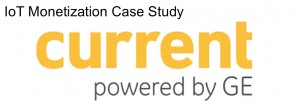
A Case Study of IoT Monetization at CURRENT, Powered by GE.
Summary
As part of the MGI Research 2016 Monetization Summit at the New York Academy of Sciences, we interviewed Patrick (PJ) Nelson, a product manager and monetization architect from Current, to discuss the opportunities and challenges of selecting a partner for the rating and billing engine inside of Current’s offering. The case study note attached below is based, in part, on that interview.
GE, one of the most respected companies in the world and an icon of the industrial sector, is reinventing itself as a digital innovator. GE’s goals are ambitious, to say the least. Across its business units, GE is creating digital companies that leverage core assets. One of these new businesses is Current, powered by GE. It combines GE’s LED, solar, energy storage, and electric vehicle capabilities under one umbrella and adds a digital business platform that can measure and manage power. Current’s aim is to deliver “Energy as a Service”—quite possibly the largest “as a Service” play in the world. Creating a digital powerhouse within a 124-year-old organization that also happens to be the nation’s largest manufacturing company is not exactly an obvious exercise. To be certain, this has never been done before on this scale. Many industries experience digital disruption; however, few industrial giants to date have embraced the threats and used large-scale investment to turn these challenges into opportunities in the same way that GE has. In assembling its capabilities within Current, GE built and integrated a variety of components, including an external billing and rating engine. This case study details how GE solved the business and technical challenges inherent in its efforts to endow Current Energy Management System (EMS) with a robust monetization capability based on an embedded third-party rating and billing engine.
Company Background
Using GE Digital’s Predix platform as the foundation, the Current team is building cloud-native solutions to help customers analyze, implement, and optimize energy systems. In less than 12 months, Current has ramped up to an estimated $1 billion in revenue and is working with customers across a wide spectrum of industries, from big box retailers to manufacturers to municipalities.
There are four major components to the Current solution—Control, Insight, Optimize, and Assure.
- Control: the ability to assume direct control of powered assets—lights, refrigeration, HVAC, et al. This allows for capabilities including highly granular controls such as over individual device and fixture settings.
- Insight: the ability to measure the power usage for any device and provide detailed insights and analytics.
- Optimize: the capability to intelligently combine the information provided by Control and Insight and recommend optimal decisions for power settings down to a device and light fixture level.
- Assure: the ability to take usage and interval events and provide near real-time rating of usage events/data. Assure collects all of the utility data—the bills and the interval data—and automates the analysis and payment of bills. Assure provides assessment and superior insights to inform contract negotiations with energy suppliers and optimize power spend.
Industries Served by Current
- Municipal
- Retail
- Commercial Office
- Hospitality
- Banking
- Manufacturing
- Universities
- Transportation
- Healthcare
Project Background: Multiple, Complex, and Evolving Constraints
Faced with the task of delivering a completely new energy management system (EMS) as part of the overall Current offerings, the GE team encountered multiple, complex constraints. One of the key challenges was a requirement for the Current platform to support highly granular rating and billing of power usage while also providing insights into the economics of power consumption.
Build vs. Buy or Rent: Accelerate Time-to-Market
When it came to monetization, the question of build versus buy/rent was both an economic and a strategic issue for Current. GE had the luxury of being able to build just about anything. GE has significant internal engineering resources, and GE Digital has assembled more than 1,400 software developers, including several top-notch monetization experts. The team was highly experienced in developing monetization capabilities and was completely competent to build its own system in-house. However, early in the project, the GE team recognized that internal development would take time away from other project priorities and likely wouldn’t deliver the same sophisticated capabilities already available in the market, so the decision to embed a third-party rating and billing engine into the Current solution prevailed. This direction supported GE’s objective to speed up deployment, but it also forced the Current team to gather, assemble, and prioritize functional requirements within a business that was moving at warp-speed. Current made a conscious decision to leverage domain expertise wherever it could be found–internally or externally–across a spectrum of functional capabilities and to emphasize time-to-market as a primary decision driver. Thus, Current elected to buy or rent capabilities in several functional areas rather than to allow the “not invented here” stigma to slow its aggressive timelines.
Key Issues Addressed by this Case Study
- How will companies monetize the emerging IoT business opportunities?
- How will monetization platforms evolve to support new digital business models?
- What are the winning strategies for monetizing IoT?
- What are the hidden benefits and unforeseen risks of AMP?
Key Decisions Addressed by this Case Study
- Build vs. Buy
- Balancing of multiple complex constraints
- Monetization requirements gathering for a constantly evolving core platform
- Scalability
- Security
- Complexity
- Supplier Selection

